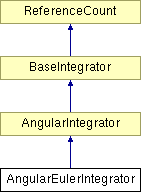
#include <angularEulerIntegrator.h>
Inheritance diagram for AngularEulerIntegrator:

Public Member Functions | |
| AngularEulerIntegrator (void) | |
| constructor | |
| virtual | ~AngularEulerIntegrator (void) |
| destructor | |
| void | integrate (Physical *physical, pvector< PointerTo< AngularForce > > &forces, float dt) |
| high-level integration. | |
| int | get_ref_count () const |
| Returns the current reference count. | |
| int | ref () const |
| Explicitly increments the reference count. | |
| int | unref () const |
| Explicitly decrements the reference count. | |
| void | test_ref_count_integrity () const |
| Does some easy checks to make sure that the reference count isn't completely bogus. | |
Static Public Member Functions | |
| TypeHandle | get_class_type () |
| void | init_type () |
Protected Member Functions | |
| const pvector< LMatrix4f > & | get_precomputed_linear_matrices (void) const |
| const pvector< LMatrix4f > & | get_precomputed_angular_matrices (void) const |
| void | precompute_linear_matrices (Physical *physical, const pvector< PointerTo< LinearForce > > &forces) |
| effectively caches the xform matrices between the physical's node and every force acting on it so that each PhysicsObject in the set held by the Physical doesn't have to wrt. | |
| void | precompute_angular_matrices (Physical *physical, const pvector< PointerTo< AngularForce > > &forces) |
| effectively caches the xform matrices between the physical's node and every force acting on it so that each PhysicsObject in the set held by the Physical doesn't have to wrt. | |
Private Member Functions | |
| virtual void | child_integrate (Physical *physical, pvector< PointerTo< AngularForce > > &forces, float dt) |
| Integrate a step of motion (based on dt) by applying every force in force_vec to every object in obj_vec. | |
Definition at line 36 of file angularEulerIntegrator.h.
|
|
constructor
Definition at line 36 of file angularEulerIntegrator.cxx. |
|
|
destructor
Definition at line 48 of file angularEulerIntegrator.cxx. References BaseIntegrator::get_precomputed_angular_matrices(), and BaseIntegrator::precompute_angular_matrices(). |
|
||||||||||||||||
|
Integrate a step of motion (based on dt) by applying every force in force_vec to every object in obj_vec.
Implements AngularIntegrator. Definition at line 64 of file angularEulerIntegrator.cxx. References NULL. |
|
|
|
Definition at line 40 of file baseIntegrator.I. Referenced by ~AngularEulerIntegrator(). |
|
|
Definition at line 29 of file baseIntegrator.I. References BaseIntegrator::_precomputed_angular_matrices, and INLINE. Referenced by LinearEulerIntegrator::~LinearEulerIntegrator(). |
|
|
Returns the current reference count.
Definition at line 183 of file referenceCount.I. Referenced by RenderState::determine_bin_index(), RenderEffects::determine_show_bounds(), FontPool::ns_garbage_collect(), TexturePool::ns_garbage_collect(), MaterialPool::ns_get_material(), and TexturePool::ns_release_texture(). |
|
|
||||||||||||||||
|
high-level integration. API. Definition at line 57 of file angularIntegrator.cxx. |
|
||||||||||||
|
effectively caches the xform matrices between the physical's node and every force acting on it so that each PhysicsObject in the set held by the Physical doesn't have to wrt.
Definition at line 124 of file baseIntegrator.cxx. References BaseIntegrator::_precomputed_angular_matrices, NodePath::get_mat(), nassertv, and NULL. Referenced by ~AngularEulerIntegrator(). |
|
||||||||||||
|
effectively caches the xform matrices between the physical's node and every force acting on it so that each PhysicsObject in the set held by the Physical doesn't have to wrt.
Definition at line 66 of file baseIntegrator.cxx. References BaseIntegrator::_precomputed_linear_matrices. Referenced by LinearEulerIntegrator::~LinearEulerIntegrator(). |
|
|
Explicitly increments the reference count. User code should avoid using ref() and unref() directly, which can result in missed reference counts. Instead, let a PointerTo object manage the reference counting automatically. This function is const, even though it changes the object, because generally fiddling with an object's reference count isn't considered part of fiddling with the object. An object might be const in other ways, but we still need to accurately count the number of references to it. The return value is the new reference count. Definition at line 225 of file referenceCount.I. Referenced by ClientDevice::ClientDevice(), EggGroupNode::find_textures(), EggGroupNode::r_apply_texmats(), EggGroupNode::r_flatten_transforms(), and EggGroupNode::reverse_vertex_ordering(). |
|
|
Does some easy checks to make sure that the reference count isn't completely bogus.
Definition at line 328 of file referenceCount.I. References INLINE. Referenced by EggNode::determine_bin(), and ReferenceCount::~ReferenceCount(). |
|
|
Explicitly decrements the reference count. Note that the object will not be implicitly deleted by unref() simply because the reference count drops to zero. (Having a member function delete itself is problematic; plus, we don't have a virtual destructor anyway.) However, see the helper function unref_delete(). User code should avoid using ref() and unref() directly, which can result in missed reference counts. Instead, let a PointerTo object manage the reference counting automatically. This function is const, even though it changes the object, because generally fiddling with an object's reference count isn't considered part of fiddling with the object. An object might be const in other ways, but we still need to accurately count the number of references to it. The return value is the new reference count. Definition at line 293 of file referenceCount.I. References INLINE. Referenced by RenderState::determine_bin_index(), and RenderEffects::determine_show_bounds(). |
 1.3
1.3